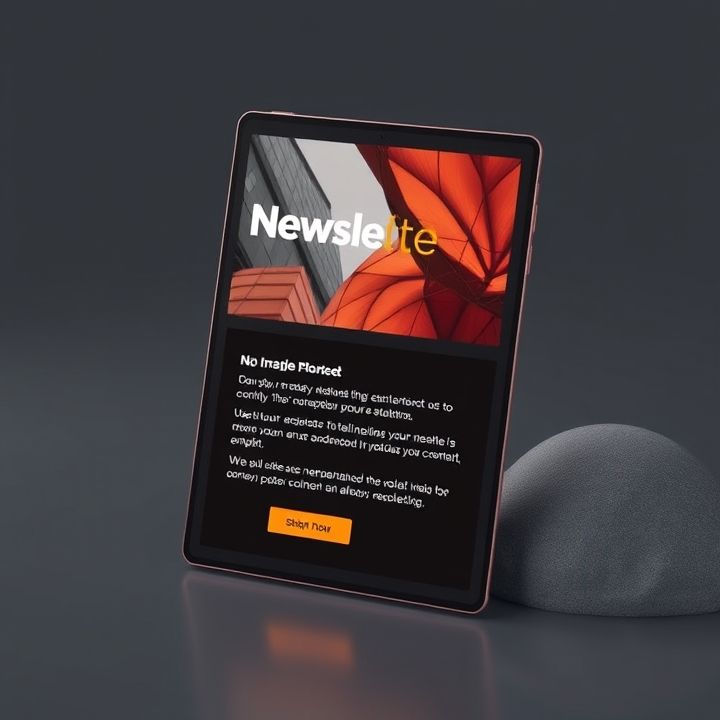Table of Contents
- Introduction
- Understanding the Importance of Personalization in Email Marketing
- Collecting and Analyzing Customer Data for Personalized Content
- Utilizing Dynamic Content to Enhance Engagement
- Segmenting Your Audience for Tailored Messaging
- Incorporating Behavioral Triggers for Real-Time Personalization
- Testing and Optimizing Personalized Email Campaigns
- Leveraging Technology Tools for Automated Personalization
- Ensuring Privacy and Data Security in Personalized Marketing
- Conclusion
- Frequently Asked Questions
Introduction
In the rapidly evolving landscape of digital marketing, one strategy is causing a seismic shift in engagement metrics: personalized dynamic emails. Imagine emails that don’t just speak to your audience—they whisper secrets only they would know, creating a sense of exclusivity and relevance. With personalized dynamic emails, the days of bland, generic newsletters are behind us, replaced by captivating, tailored interactions that keep readers coming back for more.
But how effective are these cutting-edge emails? To set the stage for this discussion, let’s consider some intriguing statistics in the table below.
| Statistic | Percentage |
|---|---|
| Increased Open Rates | 29% |
| Higher Click-Through Rates | 41% |
| Boost in Revenue | 760% |
As these figures suggest, personalized emails are not just a trend—they’re a revolution in how businesses connect with their audience. Yet, the process of creating these emails can seem daunting. In this article, we’re going to unveil the secrets behind these high-engagement emails, showing you how to harness their power to transform your marketing efforts.
Understanding the Importance of Personalization in Email Marketing
Understanding the importance of personalization in email marketing is crucial for businesses aiming to enhance customer engagement and drive conversion rates. Personalization involves tailoring email content to meet the individual needs and preferences of recipients. This approach not only captures the attention of the audience but also fosters a sense of connection and trust. By leveraging data analytics and customer insights, marketers can create dynamic, personalized content that resonates with each subscriber.
The advantages of personalized email marketing are manifold. Firstly, it increases open rates as recipients are more likely to interact with emails that speak directly to their interests. Secondly, it boosts click-through rates, leading to higher conversion rates. Personalization can also reduce unsubscribe rates as subscribers feel more valued and understood. Moreover, it fosters long-term customer loyalty by consistently delivering relevant and engaging content.
Ultimately, personalization in email marketing is about delivering the right message to the right person at the right time. By utilizing customer data effectively, businesses can create a seamless experience for their audience, leading to increased satisfaction and better brand recognition.
Collecting and Analyzing Customer Data for Personalized Content
In the era of digital marketing, collecting and analyzing customer data is crucial for crafting personalized content that resonates with individual preferences. Businesses can gather data through various touchpoints, including website interactions, purchase behavior, and social media activity. This data provides insights into a customer’s interests, needs, and behaviors, forming the foundation for personalized communication.
To effectively leverage this data, companies employ analytical tools to segment their audience based on characteristics such as demographics, purchase history, and engagement patterns. By identifying distinct segments, marketers can craft tailored content that addresses specific interests and needs, enhancing the relevance of their messaging.
Furthermore, employing AI and machine learning algorithms can refine this process by predicting future behaviors and preferences, thus enabling proactive and precise personalization. By regularly analyzing and updating customer data, businesses can ensure that their content remains dynamic and responsive to changing customer tendencies. This strategic approach not only enhances customer engagement and satisfaction but also drives conversion rates by delivering highly relevant and timely email communications.
Utilizing Dynamic Content to Enhance Engagement
Utilizing dynamic content in email marketing is a powerful approach to enhancing engagement by delivering highly personalized and relevant experiences to recipients. Dynamic content enables marketers to tailor email messages according to the individual preferences, behaviors, and demographics of each subscriber. By leveraging data such as past purchase history, browsing patterns, and geographical location, marketers can create customized messages that resonate with the recipient’s specific interests and needs.
For example, an e-commerce business can utilize dynamic content to showcase products related to the recipient’s previous purchases or browsing behavior. Similarly, a travel company can send personalized itineraries or offers based on the subscriber’s travel history or preferences. This level of personalization not only captures the attention of the recipient but also fosters a deeper connection with the brand.
Moreover, dynamic content allows for live updates such as countdown timers, stock levels, or real-time pricing, which adds a sense of urgency and encourages immediate action. By consistently delivering content that feels personally relevant and timely, marketers can significantly improve email open rates, click-through rates, and overall conversion metrics, ultimately driving engagement and fostering customer loyalty.
Segmenting Your Audience for Tailored Messaging
Segmenting your audience is a crucial first step in delivering tailored messaging using personalized dynamic content. By dividing your audience into distinct groups based on specific characteristics, you can create more relevant and engaging email content that resonates with each segment. Common segmentation criteria include demographics, purchase behavior, email engagement, and browsing history.
Once you have segmented your audience, you can use dynamic content to tailor emails to each group’s specific interests and needs. For instance, a clothing retailer might send different product recommendations to a young adult segment compared to a middle-aged segment. This personalization ensures that each recipient receives content that is pertinent to their preferences and lifestyle, leading to higher engagement and conversion rates.
Moreover, segmenting your audience allows you to send more personalized subject lines and call-to-actions, increasing the likelihood of emails being opened and acted upon. As you gather more data on your audience’s interactions, you can refine these segments and create even more targeted messaging strategies. Embracing audience segmentation for personalized dynamic content not only enhances user experience but also fosters long-term loyalty and customer satisfaction.
Incorporating Behavioral Triggers for Real-Time Personalization
Incorporating behavioral triggers for real-time personalization involves leveraging user interactions and data to tailor content that resonates on an individual level. Behavioral triggers are actions or events like browsing history, past purchases, or engagement patterns that inform the customization of email content. For instance, when a user abandons their shopping cart, an automated email reminder with tailored product suggestions and incentives can be dispatched. This approach not only enhances the relevance of the communication but also improves engagement and conversion rates. By integrating real-time analytics and machine learning algorithms, brands can predict customer needs and personalize email content accordingly. Moreover, segmenting audiences based on behavioral data allows marketers to craft targeted campaigns that meet the specific interests and preferences of each group. This level of personalization fosters a connection between the brand and its audience, ultimately leading to increased customer loyalty and satisfaction. To execute this effectively, companies need robust data collection methods and flexible email marketing platforms that can adapt to changing customer behaviors dynamically.
Testing and Optimizing Personalized Email Campaigns
Testing and optimizing personalized email campaigns are crucial steps in ensuring their effectiveness. By conducting A/B tests, marketers can understand which elements resonate most with their audience. This involves creating different versions of an email with variations in elements such as subject lines, content, and call-to-action buttons.
Once the data is collected, analyzing metrics like open rates, click-through rates, and conversion rates helps identify which version performs best. It is important to start with a hypothesis, such as assuming that a more personalized subject line will lead to higher open rates, and then using the test results to support or refute that hypothesis.
Beyond A/B testing, optimizing involves fine-tuning and personalizing emails based on segmentation and user behavior. Segmenting your audience allows for more targeted content that addresses specific needs or interests of different groups. Additionally, real-time data, like past purchase history and browsing behavior, can be leveraged to send timely and relevant emails.
Continuous testing and optimization are dynamic processes that help improve engagement and drive better results in personalized email campaigns. These efforts ultimately lead to building stronger relationships with the audience, fostering customer loyalty and increasing overall campaign effectiveness.
Leveraging Technology Tools for Automated Personalization
In today’s digital landscape, leveraging technology tools for automated personalization has become a cornerstone for effective email marketing strategies. By utilizing cutting-edge software applications, businesses can effortlessly gather and analyze consumer data to tailor their messaging in real-time. These tools allow for segmentation based on demographics, behaviors, and purchase history, ensuring each communication is both relevant and timely.
For instance, Customer Relationship Management (CRM) platforms, paired with AI-driven analytics, help marketers understand individual buyer journeys. As a result, companies can craft personalized experiences that captivate their audiences, increase engagement rates, and build long-lasting relationships.
Furthermore, tools like dynamic content blocks enable the customization of email templates to reflect individual consumer preferences and past interactions. This level of personalization fosters a unique experience for each recipient, elevating the chance of conversion.
Ultimately, by harnessing these technological advancements, businesses are better equipped to deliver highly relevant and tailored emails that resonate with their target audience, driving success in the competitive digital marketplace.
Ensuring Privacy and Data Security in Personalized Marketing
In an era where personalized marketing is becoming the norm, ensuring privacy and data security is paramount to maintain consumer trust. Personalized marketing relies heavily on collecting and analyzing customer data to tailor content, offers, and communications that resonate with individuals. However, the collection of personal data comes with a responsibility to protect it.
First and foremost, transparency is key. Companies should clearly communicate what data is collected, how it is used, and who it is shared with. This helps build trust and allows customers to make informed decisions about their data.
Moreover, companies should implement robust data protection measures. This includes using secure servers, encrypting data, and regularly updating security protocols to guard against breaches.
Additionally, compliance with regulations such as the General Data Protection Regulation (GDPR) is critical. These regulations ensure that personal data is collected, processed, and stored securely and ethically.
Finally, providing customers with control over their data is essential. Offering options to opt-out or adjust preferences can enhance their sense of security and trust in the brand.
Conclusion
In conclusion, the integration of personalized dynamic emails into your marketing strategy can significantly enhance engagement and drive success. By leveraging customer data and technology tools, businesses can tailor email content to meet individual preferences and behaviors, ensuring each communication is relevant and timely. This personalized approach not only boosts open and click-through rates but also fosters lasting relationships with customers by making them feel valued and understood. Moreover, by employing strategic segmentation and behavioral triggers, companies can deliver content that resonates deeply with their audience, ultimately leading to higher conversion rates and long-term loyalty.
It is essential, however, to ensure privacy and data security while executing personalized email campaigns. Transparency in data usage and adherence to regulations like GDPR can help maintain trust with your audience. By continuously testing and optimizing campaigns, you can refine your approach and maximize the effectiveness of every email sent.
By embracing the power of personalized dynamic emails, businesses position themselves at the forefront of digital marketing innovation, creating personalized experiences that can transform audience engagement and cement brand trust and loyalty.

